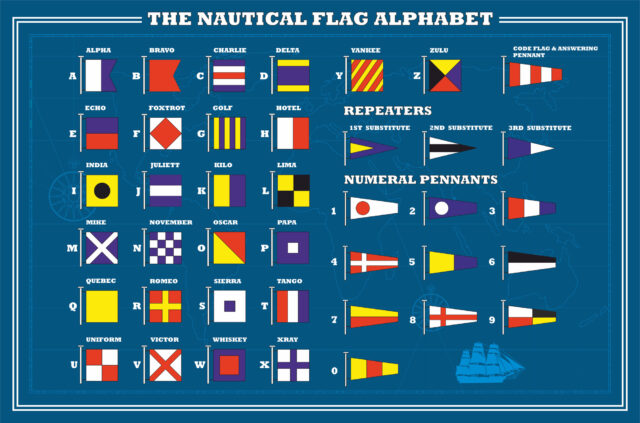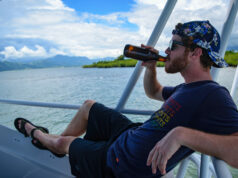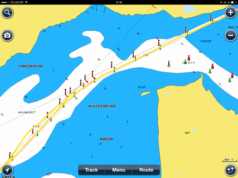Nautical flags provide a way for a boat to communicate with other boats, or with the shore, without ever using a radio. They are a form of visual communication, in which each flag has a specific meaning and can either be used by itself, or in combination with other flags.
There is a total of 26 square shape flags that represent the 26 letters of the alphabet, and 14 pendants that represent the numbers 0 through 9, along with substitutes, and the answering pendant. The flags and pendants only use 5 colors, which have been determined to be easily recognizable at sea. An individual flag or pendant may be composed of any one of the colors blue, yellow, red, black, or white.
Nautical Flags and Their Meanings
In use, nautical flags may be raised and lowered as needed. At any given time, a boat at sea may raise 1 to 7 flags if the need arises. Not only is the type of flag important to the communication, but the number of flags that are raised at the same time also plays an important role in deciphering the meaning of the signal.
One Flag
A single flag can be raised if it is being used for a common signal, or maybe use to signify urgency.
Two Flags
When two flags are raised, they can either be used to signify that the boat is maneuvering, or that it is in distress.
Three Flags
As the number of flags increases, their uses also expand dramatically. When 3 flags are raised, they can be used to signify the points of a compass, standard times, relative bearings, as well as punctuation and verbs. Sometimes, 3 flags may be used for encoding and decoding signals.
Four Flags
When 4 flags are raised, they generally represent the names of ships, as well as the ship’s bearings. But, four flags may also be used for geographical signals.
Five Flags
Five flags are used much like prepositions, in that they are used to signify relation to position and time.
Six Flags
When a boat is providing latitudinal and longitudinal signals, they use 6 flags to indicate the coordinate as well as the cardinal direction of North, South, East, or West.
Seven Flags
While 6 flags can provide latitudinal and longitudinal signals up to 99 degrees, 7 flags are needed to provide signals when they exceed 99 degrees.
The Nautical Flag Alphabet
There are 26 square-shaped nautical flags that are used to represent the alphabet from A to Z. They may be raised in order to provide a single meaning, or may be used in conjunction with numbers which provides a different meaning.
A / Alpha
The flag for A is known as a swallowtail and features a white background with a blue tail. When raised by itself, it is used to signify that other boaters should keep clear, navigate at slower speeds, or inform others that there is a diver in the area. When it is used with number pendants, it is used to provide azimuth or bearing.
B / Beta
The flag for B is also known as a swallowtail and is completely read. When raised by itself, it is used to signify that the boat is either taking in, discharging, or otherwise carrying dangerous goods or explosives. It is not generally used with number pendants to provide further meaning.
C / Charlie
The flag for C features a white background with blue bars at the top and bottom and a red bar through the center. When used by itself, it signifies an affirmative response. However, when it is used in combination with number pendants, it provides the current ship’s course in degrees.
D / Delta
The flag for D features a blue background with yellow bars at the top and bottom. When raised by itself, it is used to signify to other boaters to keep clear, or to inform other boaters that it is having difficulty with maneuvering. It is used with number pendants when providing a date.
E / Echo
The flag for E is blue on top and red on the bottom. When it is raised by itself, it is used to signify that the ship’s course is altering towards the starboard. This flag is generally not used in combination with numbers.
F / Foxtrot
The flag for F features a white background with a red diamond in the center that extends to the edges of the flag. When it is raised by itself, it is used to signify that the ship is disabled, or that the ship is expecting someone to communicate with them. The flag is not generally used in combination with numbers.
G / Golf
The flag for G features alternating vertical bars of yellow and blue. When used by itself, it signifies that the boat is being used for fishing and that it is hauling in nets, or that the ship needs a pilot. However, when used with number pendants, the first two or three pendants represent are used to represent the degrees and longitude, with the last two number pendants representing the minutes.
H / Hotel
The flag for H is half white and half red and is split vertically. When used by itself, the flag is used to signify that there is a pilot on board the vessel. It is generally not used in conjunction with numbers.
I / India
The flag for I features a yellow background with a lack, filled-in circle in the center. When used by itself, the flag signifies that the ship is altering its course towards the port. It is generally not used in combination with number pendants.
J / Juliett
The flag for J features a blue background with a white bar horizontally through the center. When it is used by itself, the flag serves as a warning to other vessels to keep clear because it is either on fire and has dangerous cargo, or because it is leaking dangerous cargo. This flag is not used in conjunction with number pendants.
K / Kilo
The flag for K is half yellow and half blue and is split vertically. When used by itself, it simply signifies that the boat wishes to communicate with another boat. However, when used with number pendants, it can be used to signify how that communication should take place. When used with the number 1 pendant, it signifies communication through Morse code or can flags. When used with the number 2 pendant, it signifies communication through megaphone. When used with the number 3 pendant, it signifies communication through a signal lamp. And when used with the number 4 pendant, it signifies communication through sound signals.
L / Lima
The flag for L features a checkerboard, with 2 yellow squares and 2 black squares in opposing corners. When raised by itself, it serves as a warning to other ships that they should stop immediately. When used in combination with number pendants, the first two pendants signify the degrees in latitude, while the last two pendants denote the minutes.
M / Mike
The flag for M features a blue background with diagonal crisscrossing white bars. When this flag is used by itself, it signifies that the vessel is at a full stop. This flag is generally not used with number pendants.
N / November
The flag for N features a checkerboard of blue and white squares on a 4 x 4 grid. When it is raised by itself, it signifies a negative response. This flag is not used in combination with numbers.
O / Oscar
The flag for O is half yellow and half red and is split diagonally. When raised by itself it is used to signify that there is a man overboard. This flag is generally attached to the overboard pole on most boats, and may also be raised independently if needed.
P / Papa
The flag for P features a blue background with a white square in the center. When it is raised by itself while in the harbor, it is used to signify that all personnel should immediately report to the vessel, as it is about to head out to sea. When it is used out at sea, it is used to signify that the vessel’s nets are caught on an obstruction. This flag is not used with number pendants.
Q / Quebec
The flag for Q is completely yellow. When raised by itself it is used to signify that the vessel is healthy, especially after the ship has been placed in quarantine and has been given a clean bill of health. This flag is not used with number pendants.
R / Romeo
The flag for R features a red background with a yellow cross through the center extending to the edges of the flag. When raised by itself it informs other vessels that they will need to field their way past. When used in combination with number pendants, it provides the distance or range in nautical miles.
S / Sierra
The flag for the S features a white background with a blue square in the center. When the flag is used by itself, it is used to inform other vessels that it is currently moving astern. However, when used with number pendants, it provides the speed or velocity in knots.
T / Tango
The flag for T features red, white, and blue vertical bars. When raised by itself, the flag generally means Tuesday clear. For fishing boats, it is intended to inform other boats that it is currently trawling, and to stay clear. When it is used with number pendants, it provides the local time, with the first 2 digits indicating the hour, and the last 2 indicating minutes.
U / Uniform
The flag for U features a checkerboard, with 2 red and 2 white squares in opposing corners. The flag when raised by itself, is used to signify to other ships that they are running into danger. This flag is not used with numbered pendants.
V / Victor
The flag for V features a white background with diagonal crisscrossing red bars. When raised by itself, this flag is used to signify that the vessel needs assistance. When it is used in conjunction with number pendants, it provides the speed in kilometers per hour rather than knots.
W / Whiskey
The flag for W features a blue border on all 4 sides, a white background, and a red square in the middle. When this flag is raised by itself, it is to inform other vessels that medical assistance is needed. This flag is never used in conjunction with number pendants.
X / Xray
The flag for X features a white background with a blue cross in the middle extending to the edges of the flag. This flag is generally raised by itself in order to signify to other vessels to pay attention to further signals. It serves as a warning to other vessels to stop what they are doing until further notice.
Y / Yankee
The flag for X features ten alternating yellow and red diagonal bars. This flag is generally raised by itself in order to inform other vessels that it is dragging its anchor. It is never used in combination with number pendants.
Z / Zulu
The flag for Z features four triangles of yellow, blue, red, and black, each extending from the edge to the center of the flag. This flag is raised by itself for a number of reasons. When close to the shore, it is used to signify that the vessel requires a tug, but when you sow at sea, it is used to signify that the vessel is shooting out nets. This flag may also be used in combination with number pendants in order to tell UTC time. When used with number pendants, the first 2 digits identify the hour and the last 2 digits of the minutes. This flag may also be used in combination with O, and W flags which indicate to other vessels that there is a man overboard and medical assistance as required.
The Nautical Flag Numbers
The number pendants are elongated triangle shapes that add further meaning to the nautical flag system. They have no further meaning than the value of the number itself.
1 / One
The pendant for number 1 has a white background with a red dot.
2 / Two
The pendant for number 2 has a blue background with a white dot.
3 / Three
The pendant for number 3 has red, white, and blue vertical bars spaced out evenly.
4 / Four
The pendant for number 4 has a red background with a white cross extending to the edges of the pendant.
5 / Five
The pendant for number 5 is half yellow and half blue, split vertically.
6 / Six
The pendant for number 6 is half black and half white, split horizontally.
7 / Seven
The pendant for number 7 is half yellow and half red, split horizontally.
8 / Eight
The pendant for number 8 has a white background with a red cross extending to the edges of the pendant.
9 / Nine
The pendant for number 9 is a checkerboard featuring white, black, yellow, and red quarters.
0 / Zero
The pendant for number 0 has a yellow background with a single red vertical bar in the middle.
Nautical flags are the secret language of ships and sailors. It is commonplace for the United States Navy to signal and communicate with other ships using nautical flags. NATO also uses the flags for sending short messages that are deemed unclassified. The flags also are used commonly for yacht racing in order to provide instructions to the competitors.








